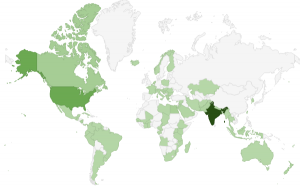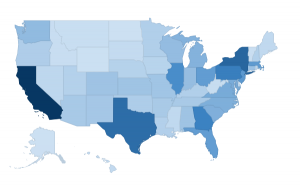The 2015 CSTA Board of Directors Elections will run from April 2, 2015 to May 4, 2015. Below are blog posts from our At-Large Board Representative Nominees. The CSTA At-Large Representative is an educator with responsibilities for K–12 CS education.
Candidate personal statements and Q&A responses can be found at http://csta.acm.org/About/sub/AboutFiles/2015Election.html.
Arkansas’s New High School CS Requirement
Daniel Moix
Arkansas Governor Asa Hutchinson made good on his campaign promise to “offer coding in every high school” last month by signing Arkansas House Bill 1183 into law. It’s an exciting time for the growing community of CS educators in the state as we scramble to help make the governor’s vision a reality. The Arkansas chapter of CSTA has been an integral part of the achievements thus far, but we have much more to do in the coming months.
The law requires the over 270 public and charter high schools in the state to offer a high-quality Computer Science course which meets standards established by the Arkansas Department of Education. The law also charges the state’s online high school, Virtual Arkansas, with offering CS courses to all districts in the state at no charge. Finally, it establishes a 15-member task force to research, review, and recommend curriculum standards and to make recommendations to meet anticipated CS and technology workforce needs.
Governor Hutchinson’s ambitious goal is to have students across the state learning Computer Science in all schools by August, 2015. To make this vision a reality, several efforts are already underway. Curriculum Frameworks for Computer Science and Mathematics, an introductory computer programming course designed to count as a fourth-year mathematics credit, were developed in late 2014. Frameworks for Essentials of Computer Programming were completed in early 2015. Both courses draw heavily from the CSTA K-12 Computer Science Standards, and members of CSTA Arkansas were on the respective committees. Virtual Arkansas is in the process of implementing both of these courses as well as AP Computer Science A in their online learning environment.
There are also professional development initiatives planned to meet the demand for CS teachers. First, CSTA Arkansas is working with colleges and universities around the state to offer summer workshops for teachers licensed in other content areas who are interested in learning to teach CS. The chapter is also submitting a CS4HS grant application to request funding from Google to help build our community of practice. The state’s second Computer Science Education Summit, planned to be held in October, will feature a track of sessions to support novice CS teachers. Other ongoing initiatives are also building out the community, including the roll-out of a three-year program of study in Mobile Application Development beginning with tools like App Inventor and GameSalad but transitioning to XCode, Eclipse, and Android Studio. Training for this program will also happen this summer for 8-10 new teachers.
Arkansas has no teacher licensure system in place for Computer Science educators. Early efforts proposed by the Arkansas Department of Education would have required Computer Science teachers be No Child Left Behind (NCLB) Highly-Qualified Teachers (HQT) in Mathematics. As it stands, any licensed educator may teach CS courses, but fourth-year math credit will only being granted to those students taught by NCLB HQT in math. Arkansas is partnering with Education Testing Service (ETS), which is currently developing a multi-state Praxis exam for Computer Science. We believe this exam will be required for CS licensure in the future.
It’s an exciting time to be a Computer Science educator in Arkansas, but we have a long road ahead of us. The role of CSTA Arkansas will be to inform the standards as they are developed and revised, identify and prepare new CS teachers, support existing teachers and CS programs, and inform the new CS Education Task Force.
Daniel Moix teaches Mobile Application Development at Bryant High School in Bryant, Arkansas. He is CSTA Arkansas Vice-President, a member of the CSTA Computer Science Advocacy Leadership Team (CSALT), a member of the Councils of Chief State School Officers’ Computer Science Advisory Group, and a candidate for the CSTA Board of Directors At-Large Representative.
CSTA – More Than Ever
Alfred Thompson
Ten years ago when CSTA started it often felt like we were a bit of a lone voice advocating for computer science education. Today a lot has changed. There are many others advocating. For profit companies and nonprofit organizations alike are pushing for more CS education. The government at local, state and national levels has taken notice. Computer Science students are showing up at White House Science Fairs and the President of the United States is writing code. As a long time member and more recently a Board member of the CSTA I get asked if the CSTA is still needed. Of course this question comes from people outside of education. My answer is a resounding “more than ever.”
When one looks at the resources and guidance that others are using the CSTA is the source. One can’t discuss certification and licensure of CS teachers without referencing CSTA research. Anyone developing CS curriculum today looks to the CSTA CS Standards for guidance. Advocates for more CS education quote research from CSTA at every opportunity. Other organizations are dependent on the work that CSTA has done for the last ten years.
But there is more to it. CSTA is THE organization for K-12 computer science educators. It is the organization of teachers for teachers. CSTA provides the community of practice that is essential for the growth of computer science education. CSTA Chapters provide local and regional learning opportunities as the chance to share ideas with peers. The Annual CSTA Conference is still the premier CS education professional development for K-12 computer science educators. CSTA is the bridge among teachers that spans local and regional issues.
I believe that the more computer science education grows the more we need CSTA. I urge all members to get involved in their local chapters, take advantage of CSTA resources and help our organization to grow. We’re all in this together!
Alfred Thompson
At-Large Member, CSTA Board


